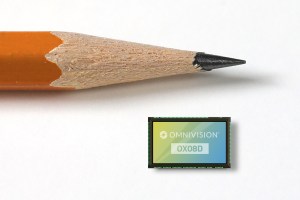Omnivision unveiled its OX08D10 automotive 8-megapixel (MP) CMOS image sensor (CIS), featuring its new TheiaCel high-dynamic-range (HDR) technology, at the recent AutoSens Brussels conference. Together, the TheiaCel technology and 8-MP CIS significantly improve LED flicker in challenging light conditions, especially in low-light environments.
Making it easier to see in challenging light conditions, TheiaCel provides a wider dynamic range than earlier single-exposure HDR architectures and enhances the resolution and image quality in exterior cameras for advanced driver assistance systems (ADAS) and autonomous driving (AD), thus improving safety.

The OX08D10 automotive 8-MP CMOS image sensor is the first to incorporate the TheiaCel technology. (Source: Omnivision)
The OX08D10 – with low-light performance and low power consumption in a compact size that is 50% smaller than other exterior cabin sensors in its class – is the company’s first image sensor that features the 2.1-micron (µm) TheiaCel technology, delivering high LED flicker mitigation (LFM) without sacrificing image quality. TheiaCel leverages next-generation lateral overflow integration capacitor (LOFIC) technology and Omnivision’s dual conversion gain (DCG) HDR technology to eliminate LED flicker regardless of lighting conditions, the company said.
Paul Wu, Omnivision’s product marketing manager, said the new technology addresses the challenges of flicker in LED traffic lights on imaging solutions, which can prevent ADAS and AD systems from accurately detecting lighted traffic signs.
Previous solutions like split-pixel technology have improved LFM, but they have also caused reduced image quality. Omnivision applied the TheiaCel technology first in automotive solutions to deliver high LFM dynamic range without sacrificing the image quality, mainly low-light sensitivity, Wu said.
With single-PD LOFIC if the pixel is saturated, the electrons can overflow to the LOFIC, so essentially it will increase the full-well capacity of the pixel, he said. “With DCG + LOFIC you can get this very high dynamic range from a single exposure, which solves motion blur and solves the mismatch between the large photodiode (LPD) and the small photodiode (PD), introduced by the split-pixel technology.”
Split-pixel sensor technology divides each pixel into large and small photodiodes. With split pixel only the LPD can be counted for the sensitivity, Wu said. With a single pixel [or single-PD LOFIC], the whole pixel size can be used for low-light sensitivity, which is why there is a big sensitivity jump with TheiaCel, he added.
Compared to the previous-generation OX08B40 with split-pixel technology, the OX08D10 full-well capacity is almost increased by 32×, which is a “really big jump” and the LPD sensitivity is increased by 70%, which is why the SNR1 can be significantly reduced and that’s directly related to the low-light sensitivity, Wu said.
In addition, the OX08D10 provides an LFM dynamic range that is 3.3× higher and a total dynamic range nearly 3× higher compared with its non-LOFIC-based predecessor. Also, thanks to TheiaCel, the OX08D10 can achieve HDR image capture at up to 200 meters. Omnivision said “this range is the sweet spot for delivering the best balance between SNR1 and dynamic range” for automotive exterior camera applications.
Another key feature of the OX08B40 is upgraded cybersecurity to comply with the newest MIPI CSE version 2.0 standards, which adds functional safety to automotive image sensor data streams. The image sensor is housed in a-CSP package technology for a small footprint.
Samples of the OX08D10 are available now. Mass production is expected in the second half of 2024.
Advertisement
Learn more about OmniVision Technologies





